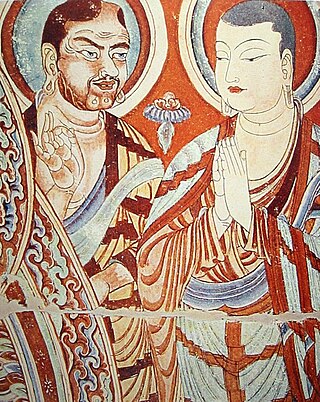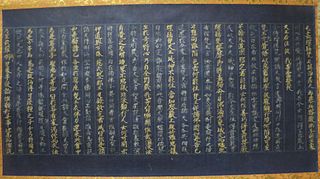
The Sarvāstivāda was one of the early Buddhist schools established around the reign of Ashoka. It was particularly known as an Abhidharma tradition, with a unique set of seven canonical Abhidharma texts.
An Shigao was an early Buddhist missionary to China, and the earliest known translator of Indian Buddhist texts into Chinese. According to legend, he was a prince of Parthia, nicknamed the "Parthian Marquess", who renounced his claim to the royal throne of Parthia in order to serve as a Buddhist missionary monk in China.

Kumārajīva was a Buddhist monk, scholar, missionary and translator from Kucha. Kumārajīva is seen as one of the greatest translators of Chinese Buddhism. According to Lu Cheng, Kumarajiva's translations are "unparalleled either in terms of translation technique or degree of fidelity".
The Sautrāntika or Sutravadin were an early Buddhist school generally believed to be descended from the Sthavira nikāya by way of their immediate parent school, the Sarvāstivādins. While they are identified as a unique doctrinal tendency, they were part of the Sarvāstivāda Vinaya lineage of monastic ordination.

The Dharmaguptaka are one of the eighteen or twenty early Buddhist schools, depending on the source. They are said to have originated from another sect, the Mahīśāsakas. The Dharmaguptakas had a prominent role in early Central Asian and Chinese Buddhism, and their Prātimokṣa are still in effect in East Asian countries to this day, including China, Vietnam, Korea, and Japan as well as the Philippines. They are one of three surviving Vinaya lineages, along with that of the Theravāda and the Mūlasarvāstivāda.

In Buddhism, an āgama is a collection of early Buddhist texts.
Paramārtha was an Indian monk from Ujjain, who is best known for his prolific Chinese translations of Buddhist texts during the Six Dynasties era. He is known as one of the four great translators in Chinese Buddhist history. He is also known for the various oral commentaries he gave on his translations which were written down by his disciples. Some of Paramārtha's influential translations include Vasubandhu's Abhidharmakośa, Asaṅga’s Mahāyānasaṃgraha, and Dignāga's Ālambanaparīkṣā & Hastavālaprakaraṇa.

The Nīlakaṇṭha Dhāraṇī, also known as the Mahākaruṇā(-citta) Dhāraṇī, Mahākaruṇika Dhāraṇī or Great Compassion Dhāraṇī / Mantra, is a Mahayana Buddhist dhāraṇī associated with the bodhisattva Avalokiteśvara.
Sangitiparyaya or Samgiti-paryaya-sastra is one of the seven Sarvastivada Abhidharma Buddhist scriptures. It was composed by Mahakausthila or Sariputra. The Chinese recension was translated by Xuanzang: T26, No. 1536, 阿毘達磨集異門足論, 尊者舍利子說, 三藏法師玄奘奉 詔譯, in 20 fascicles.
Dharmaskandha or Dharma-skandha-sastra is one of the seven Sarvastivada Abhidharma Buddhist scriptures. Dharmaskandha means "collection of dharmas". It was composed by Sariputra or Maudgalyayana. The Chinese edition was translated by Xuanzang, and appears as: T26, No. 1537, 阿毘達磨法蘊足論, 尊者大目乾連造, 三藏法師玄奘奉 詔譯, in 12 fascicles.
Dhatukaya or Dhatukaya-sastra is one of the seven Sarvastivada Abhidharma Buddhist scriptures.
Vijñānakāya or Vijñānakāya-śāstra (विज्ञानकायशास्त्र) is one of the seven Sarvāstivāda Abhidharma Buddhist scriptures. "Vijñānakāya" means "group or substance of consciousness". It was composed by Devasarman, with the Chinese translated by Xuanzang: T26, No. 1539, 阿毘達磨識身足論, 提婆設摩阿羅漢造, 三藏法師玄奘奉 詔譯, in 16 fascicles.
Prakaranapada, composed by Vasumitra, is one of the seven Sarvastivada Abhidharma Buddhist scriptures. The Chinese was translated by Xuanzang as: T26, No. 1542, 阿毘達磨品類足論, 尊者世友造, 三藏法師玄奘奉 詔譯, in 18 fascicles; with another partial translation by Gunabhadra and Bodhiyasa: T26, No. 1541, 眾事分阿毘曇論, 尊者世友造, 宋天竺三藏求那跋陀羅, 共菩提耶舍譯, in 12 fascicles. Its commentary the Panca-vastu-vibhasa by Dharmatrata, was also translated by Xuanzang.
Jñānaprasthāna or Jñānaprasthāna-śāstra (ज्ञानप्रस्थानशास्त्र), composed originally in Sanskrit by Kātyāyanīputra, is one of the seven Sarvastivada Abhidharma Buddhist scriptures. Jñānaprasthāna means "establishment of knowledge"
The Abhidharma Mahāvibhāṣā Śāstra is an ancient Buddhist text. It is thought to have been authored around 150 CE. It is an encyclopedic work on Abhidharma, scholastic Buddhist philosophy composed in around kashmir. Its composition led to the founding of a new school of thought, called Vaibhāṣika, which was very influential in the history of Buddhist thought and practice.
Buddhabhadra was a Mahayana Buddhist meditation and Vinaya master. He is most known for his prolific translation efforts of Buddhist texts from Sanskrit into Chinese, and was responsible for the first Chinese translation of the Avataṃsaka Sūtra in the 5th century. In China he is often known as the "Meditation Master from India" (天竺禪師).
The Abhidharma are a collection of Buddhist texts dating from the 3rd century BCE onwards, which contain detailed scholastic presentations of doctrinal material appearing in the canonical Buddhist scriptures and commentaries. It also refers to the scholastic method itself, as well as the field of knowledge that this method is said to study.
The Abhidharma-samuccaya is a Buddhist text composed by Asaṅga. The Abhidharma-samuccaya is a systematic account of Abhidharma. According to J. W. de Jong it is also "one of the most important texts of the Yogācāra school." According to Frauwallner, this text is based on the Abhidharma of the Mahīśāsaka tradition.
The Dhyāna sutras or "meditation summaries" or also known as The Zen Sutras are a group of early Buddhist meditation texts which are mostly based on the Yogacara meditation teachings of the Sarvāstivāda school of Kashmir circa 1st-4th centuries CE. Most of the texts only survive in Chinese and were key works in the development of the Buddhist meditation practices of Chinese Buddhism.
Saṃghabhadra : was an kashmiri scholar monk of the Sarvāstivāda Vaibhāṣika and "undoubtedly one of the most brilliant Abhidharma masters in India". Born in Kashmir, he was a contemporary of the Buddhist philosopher Vasubandhu. According to K.L. Dhammajoti, his work forms the most mature and refined form of Vaibhāṣika philosophy. His two main works, the *Nyāyānusāra and the *Abhidharmasamayapradīpikā, are very important sources for late Vaibhāṣika thought. He is referenced by various important Buddhist figures, such as Xuanzang, Kuiji, Sthiramati, and Śāntarakṣita who see him as the most authoritative of the Vaibhāṣika Abhidharmikas.
Li-Kouang, Lin. Introduction au Compendium de la Loi (Dharma-Samuccaya). L'aide mémoire de la vraie Loi (Saddharma-Smrtyupasthana-Sutra). Recherche sur un Sutra développé du Petit Véhicule, Adrien-Maisonneuve, Paris 1949.





